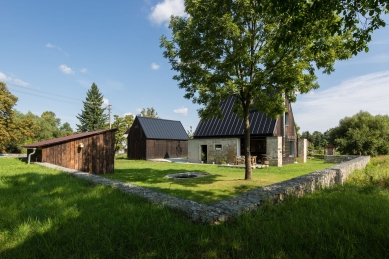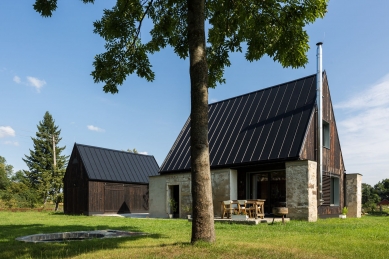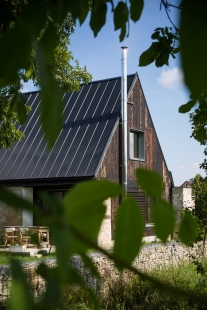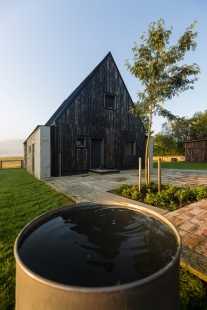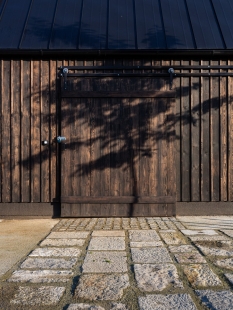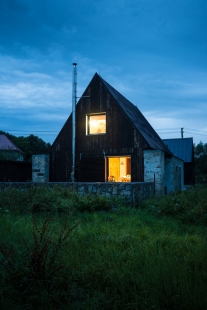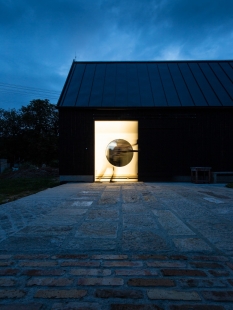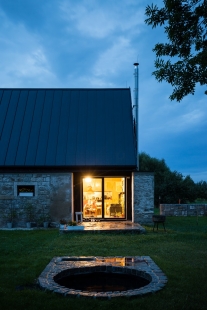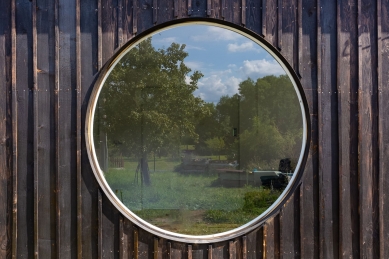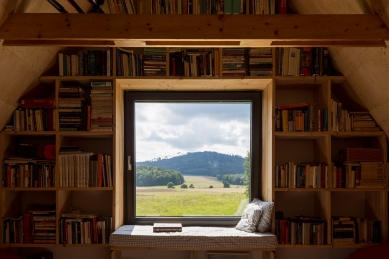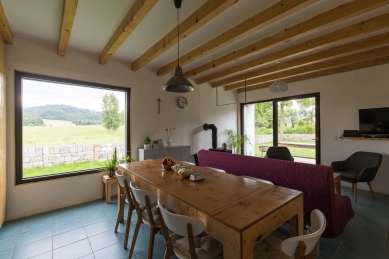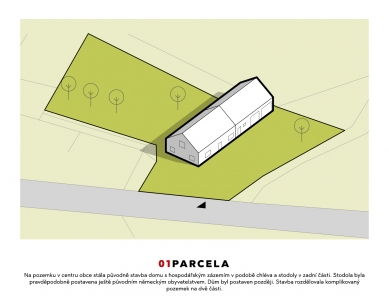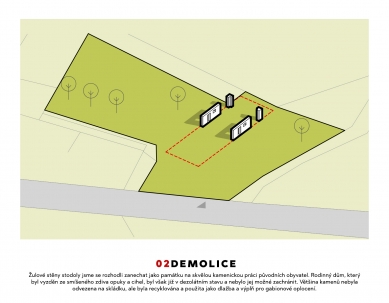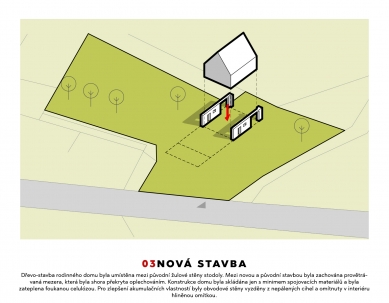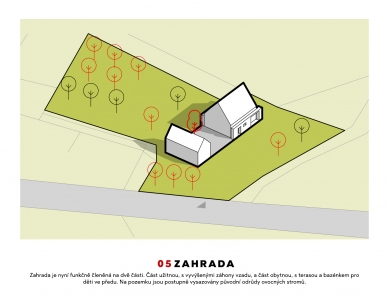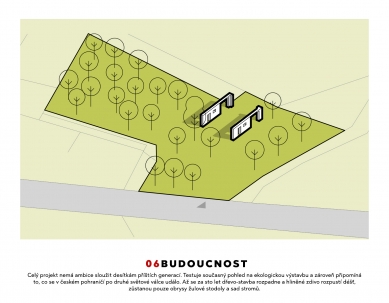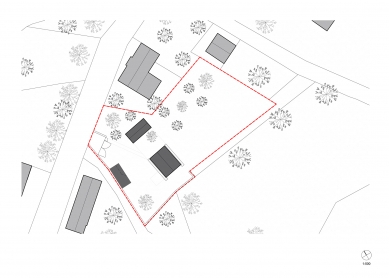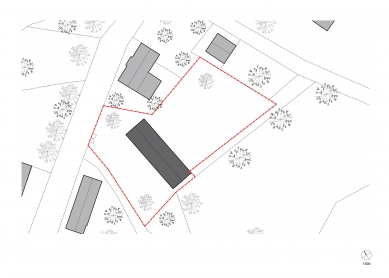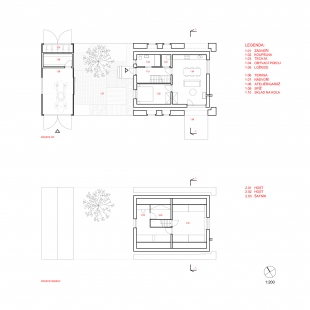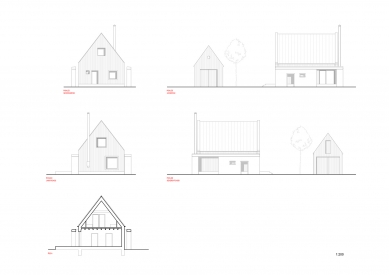
Family house for parents

Situation
The plot is located in the center of the village of Stará Červená Voda, in the former Sudetes in the Jeseníky Mountains. Originally, there was a house on the property with agricultural facilities in the form of a stable and a barn at the back.
We decided to keep the granite walls of the barn as a tribute to the excellent stonework of the original inhabitants. However, the family house, which was built of mixed stone masonry with limestone and bricks, was already in a dilapidated state and could not be saved. Most of the stones were not taken to a landfill but were recycled and used as fill for gabion fencing. A new wooden family house was placed between the original granite walls of the barn. A ventilated gap was preserved between the new and original structures, which was covered by sheeting from above.
The house construction was complemented by a transverse structure of a studio/garage. As a result, a multifunctional "square" was created between the house and the studio, serving as the center of the entire plot. Here, it is possible to dry laundry or carry out small DIY projects, grandchildren can play, or the extended family can gather around a common table. Thanks to this arrangement, both parts of the garden have been connected.
The garden is now functionally divided into two parts. The utility section, with raised beds at the back, and the living area, with a terrace and a kiddie pool at the front. Original varieties of fruit trees are gradually being planted on the property.
Gradually, more small structures are being added to the garden, such as a shed for wood and tools, or an oven for baking bread.
House Layout
The house is intended for an older couple, the parents of four already adult children, who after a lifetime spent in an apartment building decided to fulfill their dream of living in a house with a garden.
The house is not basemented, has one above-ground floor, and an attic. The total built-up area of the house is 66 m².
The first floor is designed for the parents. It contains an entrance hall, bathroom, technical room, living room with dining area and kitchen, and a bedroom. Considering the limitation of residents' mobility in the future, the entire floor is threshold-free and the bathroom is spacious enough for a wheelchair to turn around.
The staircase in the entrance hall leads to the living attic. Here, two rooms are designed to serve as guest bedrooms, primarily for children with grandchildren, and a wardrobe.
Construction
The beam system made from KVH lumber was assembled with minimal fasteners, and the structure was insulated with blown cellulose. To improve the thermal mass properties of the wooden building, the outer walls between the beams were built with unfired bricks and plastered with clay plaster on the interior. The structure is vapor-permeable. Clay plasters have an excellent ability to absorb air moisture, which they then gradually release. The atmosphere in the interior is therefore very different from that of the dry air in an apartment building. The exterior is clad with charred spruce wood. This facade protection method originally came from Japan (shou sugi ban). However, similar techniques have been used to protect the underground parts of wooden poles in fencing for centuries. The charred surface protects the wood from weathering, as well as from fungi and microbes. The windows are wooden with insulating triple glazing and are covered with galvanized sheet metal. The roof is made of black folded sheet metal. A distinctive feature of the eastern facade is also the exterior stainless steel chimney. The house is complemented from the south by a stone terrace, which is shaded by a textile canopy. Due to the overhang of the original barn walls from the south, along with the sliding shading from the east, overheating of the structure is avoided.
The building meets low-energy standards. Heating is provided by solid fuel stoves, with electric heating cables serving as a secondary source. The installation of solar panels is planned for the future.
The plot is located in the center of the village of Stará Červená Voda, in the former Sudetes in the Jeseníky Mountains. Originally, there was a house on the property with agricultural facilities in the form of a stable and a barn at the back.
We decided to keep the granite walls of the barn as a tribute to the excellent stonework of the original inhabitants. However, the family house, which was built of mixed stone masonry with limestone and bricks, was already in a dilapidated state and could not be saved. Most of the stones were not taken to a landfill but were recycled and used as fill for gabion fencing. A new wooden family house was placed between the original granite walls of the barn. A ventilated gap was preserved between the new and original structures, which was covered by sheeting from above.
The house construction was complemented by a transverse structure of a studio/garage. As a result, a multifunctional "square" was created between the house and the studio, serving as the center of the entire plot. Here, it is possible to dry laundry or carry out small DIY projects, grandchildren can play, or the extended family can gather around a common table. Thanks to this arrangement, both parts of the garden have been connected.
The garden is now functionally divided into two parts. The utility section, with raised beds at the back, and the living area, with a terrace and a kiddie pool at the front. Original varieties of fruit trees are gradually being planted on the property.
Gradually, more small structures are being added to the garden, such as a shed for wood and tools, or an oven for baking bread.
House Layout
The house is intended for an older couple, the parents of four already adult children, who after a lifetime spent in an apartment building decided to fulfill their dream of living in a house with a garden.
The house is not basemented, has one above-ground floor, and an attic. The total built-up area of the house is 66 m².
The first floor is designed for the parents. It contains an entrance hall, bathroom, technical room, living room with dining area and kitchen, and a bedroom. Considering the limitation of residents' mobility in the future, the entire floor is threshold-free and the bathroom is spacious enough for a wheelchair to turn around.
The staircase in the entrance hall leads to the living attic. Here, two rooms are designed to serve as guest bedrooms, primarily for children with grandchildren, and a wardrobe.
Construction
The beam system made from KVH lumber was assembled with minimal fasteners, and the structure was insulated with blown cellulose. To improve the thermal mass properties of the wooden building, the outer walls between the beams were built with unfired bricks and plastered with clay plaster on the interior. The structure is vapor-permeable. Clay plasters have an excellent ability to absorb air moisture, which they then gradually release. The atmosphere in the interior is therefore very different from that of the dry air in an apartment building. The exterior is clad with charred spruce wood. This facade protection method originally came from Japan (shou sugi ban). However, similar techniques have been used to protect the underground parts of wooden poles in fencing for centuries. The charred surface protects the wood from weathering, as well as from fungi and microbes. The windows are wooden with insulating triple glazing and are covered with galvanized sheet metal. The roof is made of black folded sheet metal. A distinctive feature of the eastern facade is also the exterior stainless steel chimney. The house is complemented from the south by a stone terrace, which is shaded by a textile canopy. Due to the overhang of the original barn walls from the south, along with the sliding shading from the east, overheating of the structure is avoided.
The building meets low-energy standards. Heating is provided by solid fuel stoves, with electric heating cables serving as a secondary source. The installation of solar panels is planned for the future.
THREE. FOURTEEN architects
The English translation is powered by AI tool. Switch to Czech to view the original text source.
7 comments
add comment
Subject
Author
Date
Starý dům
ježek
03.12.20 09:33
Starý dům
David
03.12.20 08:55
Starý dům 2
ježek
04.12.20 08:44
HRDOST
BRANO
04.12.20 09:44
Schöner Wohnen
Vích
04.12.20 03:13
show all comments


